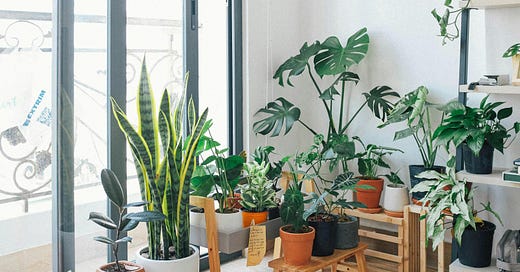Is That Bullshit? Talking to Plants
Sweet talk might not make your plants grow, but they still might respond to sound.
Talking to plants to help them grow? This idea smells like compost—full of crap. Plants don’t have ears (well, except corn), and they definitely don’t have brains. How could they possibly hear what I say, let alone care?
The fact that I couldn’t find a single serious study on the subject deepened my suspicion. Of course, no one’s researching pep talks for petunias. It’s such a silly idea, you’d be the laughingstock of the botany conference.
Legacy Media's Wilted Leads
A search of old newspaper and magazine articles was equally fruitless. Oh, there was a “study” by the Royal Horticulturalist Society, but the design was less-than-impressive: Recordings of volunteers reading famous works of English literature were played to 10 tomato plants through headphones(?) over the course of a month. The results? Female voices caused the plants to grow “up to” two inches taller than the male voices. The lack of published results, combined with their silence in response to my inquiries, left me convinced that this was a publicity stunt disguised as research.
Back in 2004, Mythbusters also took up the case, but their experiment wilted due a greenhouse irrigation failure. In 2013, a Mythbusters-branded exhibit at the Denver Museum of Nature & Science set up a system whereby a mechanical voice read Tweets sent to one of two potted plants. A representative told me that if they had any results, they’ve long since lost them.
My search did, however, unearth one interesting tidbit: According to a (questionable) survey by trees.com, 48% of people admit to talking to their plants, and a quarter of those plant talkers also kiss their greenery on occasion. In the former category, by the way, is the King of England: On at least two occasions, King Charles has admitted to conversing with greenery.
The Worm Turns
Broadening my search, I asked Consensus Pro whether plants respond to sound — and rather than nip the idea in the bud, it seeded a whole new line of investigation.
Among the studies it dug up: In 2019, a team of scientists from Tel-Aviv University demonstrated that evening primrose flowers respond to the sound of buzzing bees by ramping up their sugar production, making their nectar 20% sweeter.
It’s not exaggerating to say that this was a truly landmark paper, one that opened up a new area of research (phytoacoustics), while also advancing science’s most sacred mission: Making grad students act silly in public.
Without dragging you into the weeds, let me assure you: these researchers controlled for every imaginable confounding factor. They tested 653 flowers, both indoors and out. First, they emptied the plants of nectar. Then, mimicking the movement of bees, they carried portable speakers from flower to flower, holding each one about ten centimeters away for 30 seconds. The speakers played one of several recordings: a real bee buzz, a frequency sweep in the audible range, a sweep in the ultrasonic range, or pure silence.
The result? The flowers responded to the bee buzz recording and the audible sound frequency sweep (50-1,000 hertz), but not any of the other conditions—and they did it within three minutes of the bees passing by.
To find out what part of the flowers were sensing the vibrations, the researchers encased the flowers (but not the stems, leaves or roots) in soundproof glass. No response.
Using lasers, they then measured the natural resonance of the flowers’ petals and found that they were most responsive to 200 hertz — the buzz frequency of their preferred pollinators, bumble bees and honey bees.
This means that flowers’ petals are working much like the hair cells in our own cochleas—albeit without covering nearly as much range. (We have 16,000 hair cells that vibrate in response to 20 to 20,000 hertz.)
Here’s where it gets wild: Primrose-pollinating bees buzz overlaps nicely with the typical range of women’s speaking voices (165 to 255 hertz) but not men’s (85 to 155 hertz). Perhaps that Royal Horticulturalist Society experiment was onto something, after all!
Talk Dirt To Me
That said, the Tel Aviv scientists didn’t dig into sounds’ effects on the flower’s growth, just their nectar production.
After rooting around some more, I unearthed a 2020 study that showed that blasting strawberry plants with loud noise for several hours every day acts as a general stressor — one that, in relatively small doses, encourages more rigorous growth, but stunts them if played for more than three hours at a time. The researchers, however, do not recommend that you start yelling at your garden like a drill sergeant, as this may scare off pollinators.
Other examples of plants eavesdropping include Arabidopsis (mustard-family) plants, which increase their production of bad-tasting chemicals in response to the sound of caterpillars munching, and pea plants, which have roots that grow towards the sound of running water.
So, what’s the verdict? Well, I can imagine a lonely houseplant, raised in relative silence, perking up after visits from a human with a pollinator-pitched voice. Less likely, though, is the idea that outdoor plants would swoon over the occasional pep talk. Out there, the air is already buzzing with more consistent, ecologically meaningful sounds — bees, breezes, and maybe the occasional caterpillar chewing its way through lunch. Compared to that, even royal chatter is just background noise.







I talk to my plants the same way I talk to my WiFi router — gently at first, then increasingly desperate. Glad to know at least the primroses might be listening. Pity I was reading them bedtime bee facts for nothing.
⬖ Whispered between edits at Frequency of Reason: https://tinyurl.com/39hx4kjv